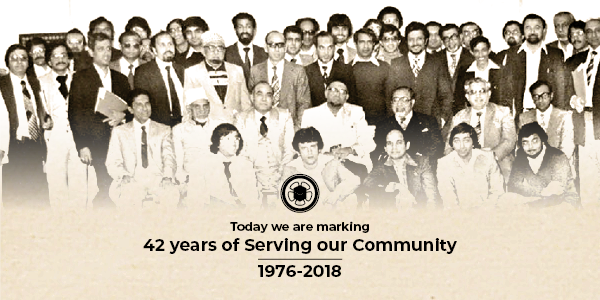A summary of Grand Ayatollah Sistani’s advice to the youth.

History of The World Federation of KSIMC
In 1976, the World Federation was established, unifying the disparate jamaats of the Khoja Shia Ithna Asheri community worldwide under its headship. Preceded by the Africa Federation formed in 1946, the new World Federation stemmed from the needs and growth of Khoja Shia communities in the USA, Canada, UK, UAE, Far East and elsewhere. In attending to the community’s financial, spiritual and educational needs globally ever since, the World Federation has passionately followed its motto ‘We exist to serve’.
The World Federation is a registered charity in the UK and world renowned for its efficient and well-organised humanitarian and religious contribution to the Shia world, The World Federation’s achievements are a dynamic tribute to the selfless dedication of its members.
While the scope and achievements of the WF have been dramatically extended over the years, the objectives remain the same. These include:
• promoting the Shia faith worldwide
• alleviating poverty, disease and dependence
• educating community members
• facilitating, funding and supporting communal endeavours
• rising to the assistance of Shia communities internationally within its capacity
From the start, The World Federation has been an organisation based on democratic process and constitutional values. The World Federation was born by unanimous assent at the 1976 Constitutional Conference in London. Thereafter, its constitution, previously drafted by a sub-committee, was accepted by majority accord. This was then followed by the election of office-bearers.
Today, The World Federation continues to operate under this constitution and is run by an elected President and his appointed Executive Council that oversees the activities of the Secretariat. The Secretariat, led by the Secretary General, comprises of full and part-time staff from jamaats all over the world. This team of volunteers coordinate their activities through specialised Boards and Desks. Catering to specific areas of need, the five boards are The Islamic Education Board (IEB), the Medical Advisory Board (MAB), the Careers Education and Training Advisory Board (CETAB), Zainabiyya Child Sponsorship Scheme (ZCSS) and the Seniors Advisory Board (SAB). Running parallel are the Women’s Desk (WD), Youth Network Desk (YND), External Liason Desk, IT and Media Desk and Research and Development Desk. While these Boards and Desks function independently, each is represented at World Federation triennial conferences in which new policies and resolutions are passed. Press releases of the conferences are available to the public as are issues of ‘Shia World’ Magazine, published since 1976 to keep the public informed of our activities.
From East Africa Federation to the World Federation
‘Let me begin at the beginning. The concept of the World Federation dawned upon us by the events in Uganda.’ So began Marhum Mulla Asgherali M.M. Jaffer’s inaugural address at the First Constitutional Conference of the World Federation (1976).
In his book, The History of Khojas, Mulla shares how the World Federation historically evolved. Going back in time, dhows carrying the first Khojas docked on the shores of Zanzibar in 1840. Primarily from Cutch and Kathiawad, regions of India fraught with famine and poverty, these young Indians braved their way through foreign territories to explore new opportunities and seek their livelihood. These pioneers formed a closely knit support system based on mutual trust and dependability that helped these settlers establish home far from India. Most of the Khojas landed in Zanzibar and then moved into the interiors. Known for their reliability, the Khojas flourished and grew, contributing greatly to the overall economy of their countries. Forming communities called ‘jamaats’, these jamaats represented their Muslim identity and cultural connection with others of similar origin and circumstance. They were established with constitutions based on democratic principles, uniting people within self-governing communities.
As communities grew in sizes, dispersion became a concern. In the early 1930s, writers began to propagate the idea of a centralized organization to which all these Jamaats would be affiliated. In 1946, the East Africa Federation was established. Its leaders in the years that followed were visionary, self-sacrificing, and courageous, establishing strong foundations for centralisation of Khoja jamaats. In 1961, other Jamaats joined this central organisation, expanding the scope of the central organisation, and hence, establishing The Africa Federation. The Africa Federation played a crucial role in guiding the Shia Ithna Asheri communities of Africa, especially in finding its place in the world where rapid changes were taking effect - technologically, scientifically and politically.
In 1964, The African Federation addressed the challenges of the revolution in Zanzibar. It assumed the unprecedented role of assisting displaced members of the community in the face of political upheaval. In 1972, the Federation faced another challenge stemming from the exodus from Uganda. Evicted from their homes under Idi Amin’s racist regime, scores of families had no choice but to migrate. In the years following this mass exodus, Khojas continued to shift and resettle, for various reasons, to England, USA, Canada and other European countries.
With resilience and God’s mercy, these families settled into new lands but their ties with the Federation of Africa weakened under the strain of new demands and geographical distance. Amazingly though, no sooner had the displaced families settled back into a routine of sorts, they began to organise themselves into Jamaats as they had in Africa. Very soon, mosques were built, centers established and the same sense of community that had brought Khojas together when they faced a new life in Africa appeared to draw together the displaced members of the community in their new lands. Hence, the Khoja identity was sustained and flourished, offering comfort and hope to those who had lost so much.
The need to centralise and renew connections between communities in the East and West began to be felt globally. In 1976, following a meeting convened to bring together all the Khojas of the world, The World Federation was established. The experienced Khoja leaders from Africa contributed greatly to the establishment and growth of The World Federation, nurturing and guiding the WF through its infancy to establish stability and reputation as a global central organization for Khoja Shia Ithna Asheri members of the world.
The Formative Years: 1976 - 1985
Once established, the World Federation faced two immediate, if ambitious, tasks. One was to raise the balance of funds from zero. Along with Khums monies, donations were the primary source of revenue in the first term, with £90 000 received by 1979. Secondly, requests received from areas as far off as Vancouver, the Bahamas and Bangkok had to be met. The first step was to assess each particular situation and to this effect Maulana Syed Amir Husain Naqvi was appointed to tour the jamaats in America, Europe, Canada and the Far East and produce a detailed report of each area. Thereafter, with limited funds, the unenviable job of prioritising requests began.
On balance, the WF’s first two terms (1976-79, 1979-1982) were dedicated to alleviating the abject poverty of the East. Removing disease, poverty and illiteracy within India was the pressing priority. To work more effectively, the central body of the WF coordinated its activities with representative bodies on the ground. In conjunction with the Masoomeen Trust of Bombay, housing complexes, madrassahs, masjids, imambarghas and medical treatment camps were funded and run. After attempts to create an All-India Federation floundered, the Gujarat Federation was set up in 1979 with the unified objective to uplift the Shias of Kutch and Khatiawad. Initial temporary relief in the form of handouts soon made way for capital schemes of investment in housing, education, agriculture and job creation. Under its leadership, the Zainabiyya Child Sponsorship Scheme was launched in 1981 to sponsor the poor to educate themselves out of dependence. Sponsoring 9 children at the cost of 50 cents per child/day in 1981, the number of students rose to 610 by 1984. The scheme now sponsors thousands of children in Bangladesh, India and Thailand. Read the rest of this summary here.
Era of Entrenchment : 1985-1995
Neither did the end of the first decade of World Federation service close an old chapter nor did the second herald a distinctly new one; rather, one passed seamlessly into the other, the same zeal and selfless dedication persisting.
The same boards and committees continued to serve; yet a decade of experience and growth was subtly making its mark. By 1990 the number of students sponsored under ZCSS had risen to 1700. In a setting where children as young as seven were recruited to labour in the mines, cotton mills or in the streets selling bidis, educating these children provided immense benefits - both immediate and long-term. In the 1980’s, education for poor children took on a new dimension with the WF paying for the freedom of children sold into debt slavery and then sponsoring their schooling. Fighting poverty on other fronts, the WF continued its assistance of Gujarat Federation projects. In addition, working in India alongside the Imam Zamana Mission, Masomeen Trust, and other local bodies, schemes of housing, education, religious training, agriculture etc. continued to expand, with particular focus on the slums of Govandi, the shantytowns of Bihar and the filthy hamlets of Qayamnagar (Hyderabad) amongst others. With the birth of the Kutch Federation in 1990, rejuvenation projects were accelerated in Kutch, particularly housing schemes in Bhuj. The WF also was quick to respond in crisis, with emergency aid provided in 1991 in coordination with local organisations, to repair housing damage due to heavy rains in Alipur.
Healthcare continued to be a prime concern. MAB volunteers worked selflessly in spite of huge costs of £10 000 per annum. Amongst it’s achievements were the improvements in the Hajj Medical Mission. Beginning with only two doctors, overseas medical supplies and no base forcing doctors to treat as they travelled, the Hajj Medical Mission by 1990 incorporated 5 doctors (along with a list of volunteers on a waiting list), local and overseas supplies, and an independent base of operation from which each doctor saw up to 300 patients a day. Later, as hajj groups multiplied, expanded and were better organised, the Hajj Medical Mission outlived its medical function and in 1993, sensibly altered its role to become an advisory body assisting hajj groups through leaflets, videos, books, seminars etc. Read the rest of this summary here.
Rising International Service and Stature: 1995-2006
Having spent a mere £10 000 in its first year, by 1996, the WF’s bill for communal welfare had risen to $43 million over 20 years. Over two decades, the various boards and desks also had expanded and refined their roles. Moreover, the World Federation had extended the geographic scope of its services to areas as disparate as Kuala Lumpur, Tataristan (Russia), Guyana and Bosnia.
Entering into middle-age, the IEB of the World Federation, stepped up its efforts of tabligh in these far-flung corners. In 1992, during the Bosnian crisis, the WF had recognised the Bosnian need for a better understanding of Islam. By 1993, the IEB had already published basic Islamic literature including a first-course in Islam and a Bosnian translation of the Holy Qur’an. From 1997-2002, regular issues of ‘Muslimanski zivot’ provided bite-sized guidance. A correspondence course on Islam was also set up to operate via the Bosnian desk, with 1200 students enrolled by 2000. During this period also, as Albanian Muslims suffered persecution and war in nearby Kosovo, the WF not only provided relief aid but launched a tabligh programme based on the Bosnian template. Under the IEB, 5 000 copies of an Albanian translation of the Qur’an, ‘The Roots of Religion’ and other basic works translated into Albanian were distributed. On another continent, the World Federation in conjunction with the Bilal Muslim Mission of the Americas continued its tabligh work in Central and South America including the Caribbean Islands. As the BMMA established madrassahs and mosques in Trinidad and Guyana and furthered Islamic awareness in the Solomon Islands and Columbia, the WF extended its assistance whenever required. Read the rest of this summary here.
Moving Ever Forward: 2006-2009
The World Federation’s 10th Triennial Conference in Dubai in 2006 marked a new progression in its history and organisation. As leaders celebrated 30 years of service to Islam and humanity, they also searched for ways to enhance future achievements. In line with this dynamism, the WF also sharpened the thrust of its focus to create the following new vision and mission statements:
'The World Federation exists to achieve the pleasure of Allah SWT by developing spiritual and vibrant communities serving humanity.'
'The World Federation enables its member institutions to promote the values and practices of the Islamic Shia Ithna Asheri Faith for the spiritual and material well being of humanity at large.'
During the conference, The President of The World Federation candidly noted that there was no ‘clear demarcation of responsibilities’ between the jamaats, regional federations and called for a ‘need to mark the next stage in the development of our community institutions.’ Upon discussion, an historic resolution was passed, authorising the Executive Council to demarcate a clear and detailed framework of roles and responsibilities.
Having started the ball rolling, the Executive Council then approved the restructuring of the organisation in February 2007. This proceeded from a discussion with leaders of all the regional federations through a Regional Summit. The Memorandum of Understandings to which leaders of all the regional federations agreed, served to create a platform for the delineation of roles between the WF and regional bodies to prevent work duplication. It also clarified the focus of the WF as a strategic body responsible for policy making and the role of regional federations to deliver projects in line with policy. Leaders at the following day’s Executive Council meeting then approved a new structure in which the Secretariat of the WF would appoint assistant secretary generals to lead five general departments:
• Education
• Tableegh
• Family Affairs
• Health
• Relief and Economic Development
The aim of this new structure was to make the relationship between The World Federation and regional federations more coherent, while allocating the lion’s share of responsibility and autonomy in project management to the regional federations.
The above reflects a commitment to adapting strategies to changing times and needs, while upholding core principles - a salient feature of The World Federation’s success. Moreover, a strong sense of accountability enables the WF to continually introspect and improve itself. Read the rest of this summary here.
Expanding Horizons 2009-2015
The year 2009 was a ‘annus horribilis’ for The World Federation. Errors in the election process of the election of the President had surfaced followed by the absence of the Electoral Commissioner at the beginning of the conference and his failure to submit his report to the 2009 Conference. Thus the 2009 Conference was an unusual one because it was the first conference without a President Elect in place. This anomaly had to be resolved and hours of deliberations took place. The unity, rationale and the democracy within the organization prevailed and the Conference resolved that the tasks of the Electoral Commissioner to be absolved and recommended that the next Executive Council undertake a study into the past election process (2009) and report within a year to the Executive Council. It also resolved that a constitutional conference to be convened in December 2010 in the UK to amend The WF presidential election method and processes. The Conference then elected an Electoral commissioner to complete the term 2006-2009. The election for the posts of the President, Vice President, Hon. Treasurer and Five elected Executive Councillors and the Electoral Commissioner then took place.
The turbulent times continued within the community but once again the unity prevailed and it resolved to move forward in an organized way. The Extraordinary Conference held in May 2010 after reviewing the elections of the term 2009-2012 determined that fresh elections be held after effecting any amendments necessary to The Constitution relating to the processes and conduct of elections. At the same Conference, The Council of Gujrat resigned as a Regional Member of The World Federation. In October 2010, The Federation of Khoja Shia Isna Asheri Jamaats of Pakistan (Pakistan Federation) became a Regional Member of The World Federation.
The 2010 Constitutional Conference held in December amended the Standard Operating Procedure for Electing the President of The World Federation from being first pass the post to an Electoral College system. The revised SOP remains to be tested as there was only one nomination for the post of the president for the term 2011-2014.
The turbulent times for the organization were over and it returned to even keel to serve the community in earnest. The aspirations of the Muballigheen Training Programme (MTP) were dented with costs overruns and lack of student registration due to its application rigidness and requirements. With the increase in political upheaval in Syria, the MTP was eventually laid to rest once the students enrolled, had completed their studies.Read the rest of this summary here.
The History of The World Federation of KSIMC article was taken from KhojaPedia - to read the entire article please click here: http://khojapedia.com/wiki/index.php?title=History_of_The_World_Federati...
Related News
Related News
On this auspicious occasion of the birth of Imam Ali (as), let us follow the footsteps of our Mawla, The Father of the Orphans and Those in Need, to help make a difference this Shahr Ramadan.
Due to the spread of COVID-19, the Government of Pakistan decided to shut down all the business and social activities. With this complete lockdown our community members also got affected especially those who were working on daily wages or running a small business. Find out more about this here.












